Among the environmental problems in the modern world, the “greenhouse effect” caused by excessive carbon dioxide and other greenhouse gases has become increasingly serious and has become an urgent problem to be solved, and my country has a large amount of natural gas resources, which has become the focus of this research. The core meaning is that the catalytic reaction of CH4-CO2 reforming can deal with the air pollution caused by carbon dioxide gas and realize the optimization and integration of natural gas resources.
This topic mainly discusses the application of cordierite as a carrier of nickel-based catalyst in the carbon dioxide reforming reaction of methane to synthesis gas. Cordierite as a carrier exhibits good mechanical properties and thermal stability. The experiment compares the difference between magnesium oxide and β-molecular sieve-carrier nickel-based catalysts in the catalytic reaction. catalytic activity and stability. The surface morphology and composition of the catalysts were characterized by X-ray diffraction (XRD), thermogravimetric analysis (TG-DTG), and scanning electron microscopy (SEM).

The results show that cordierite as a carrier exhibits good catalytic activity and selectivity, the optimum loading of Ni is 10%, the optimum calcination temperature is 773K, the optimum reaction temperature is 1023K, and the optimum feed gas ratio is CH4/ CO2=0.7.
In this paper, the catalytic performance of the nickel-cobalt two-component catalyst was also studied. By adding Co to the Ni/Crd (cordierite) catalyst as the second active component to form a nickel-cobalt two-component catalyst, this was used as the research object, and combined with X-ray diffraction (XRD) and temperature programmed reduction (TPR) to characterize The analytical method was used to investigate its catalytic activity for methane carbon dioxide reforming reaction. By comparing with the single metal active component catalyst, the ideal bimetallic component distribution ratio was obtained, and the influence of impregnation sequence and preparation method on the catalyst performance was also explored. Experiments show that the catalytic activity of nickel-cobalt bimetallic catalysts is generally higher than that of single active component catalysts, and the catalytic activity reaches the highest when the ratio of nickel to cobalt is 5%Ni-5%Co/Crd. The catalytic activity of the catalyst prepared by the impregnation sequence of cobalt first and then nickel was higher than that of the reverse order, and compared with the ordinary impregnation method, the catalyst prepared by the Sol-Gel method had better catalytic performance.
